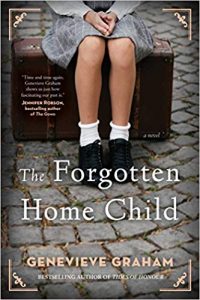The Forgotten Home Child
 For the past ten years or so, I have made it my mission to learn as much as I can about Canadian history. Back then, I was as surprised about my own enthusiasm for the subject as my high school history teacher would have been. After all, I had slept through most of those classes, bored silly. But when my family and I moved to Halifax, Nova Scotia in 2008 and I learned for the first time about the Halifax Explosion – the largest manmade explosion the world had ever seen until Hiroshima – I realized I had so much to learn.
For the past ten years or so, I have made it my mission to learn as much as I can about Canadian history. Back then, I was as surprised about my own enthusiasm for the subject as my high school history teacher would have been. After all, I had slept through most of those classes, bored silly. But when my family and I moved to Halifax, Nova Scotia in 2008 and I learned for the first time about the Halifax Explosion – the largest manmade explosion the world had ever seen until Hiroshima – I realized I had so much to learn.
So when I ran across an article about the British Home Children a few years ago, I was hooked.
From 1869 to 1948, between 100,000-130,000 destitute British children aged three to eighteen were taken from England’s streets, orphanages, and Homes, then shipped across the ocean to work as indentured servants, many without their parents’ knowledge. The majority were sent to Canada. The more I read, the more intrigued I became. How could something so significant have happened here without it becoming general knowledge? Why had I never learned about this in school?
I read all the non-fiction books I could find on the subject, then found the website for the Canadian British Home Children, but it wasn’t until I joined the multiple Facebook pages for British Home Children descendants that I understood just what I had gotten myself into. Most of the members on those pages have at least one British Home Child in their family tree, and everyone shares a common goal. They are there to learn more about their family history, but most of all they want to raise public awareness about some of Canada’s earliest and youngest pioneers, the children who helped make our country what it is today.
When I mentioned to the groups that I was writing a novel based on the British Home Children, I was welcomed with open arms. They were so full of information, so willing to share! Needing to understand the individual children’s experiences more deeply, I put together a survey. Within a week, I had over two hundred responses. Many of them broke my heart.
Because while the intent of the British Home Children emigration scheme was positive, something went very, very wrong along the way. Without regular checks and balances, the children were at the mercy of their “masters”, which often meant there was no one to protect them from rampant neglect and abuse. Fortunately, about 25% of the children did not suffer maltreatment. Some were even informally “adopted” by fine Canadian families. To those children, Canada provided escape from a life that was not unlike those described in Dickens’ novels.
But most were not that lucky, as I learned from their descendants’ survey responses. Their comments shaped the core characters of my book.
Everything you will read about in The Forgotten Home Child happened to the actual Home Children. Children who had known nothing but the dirty streets of Victorian London were suddenly faced with a barn full of cows that required milking. Children whose lives had been spent huddled within broken walls suddenly stood alone in the vast farmlands of early Canada.
Children who had been promised that Canada was a chance for a “better life” were forced to work in the snow in bare feet, sleep in sheds or leaky attics, and were beaten for small infractions. In her survey, one descendant wrote about her grandmother falling asleep in a haystack in the barn and being whipped for it. The granddaughter said, “When I grew up, she lived with us and she would take my school books to learn. When I would go to retrieve them, she would jump up and state, ‘I am not sleeping!’” The poignancy of that story, and the fact that decades later it still impacted that woman so deeply, wouldn’t let me go.
There were many other, even more difficult stories to accept. A large percentage of the girls suffered sexual abuse and rape. Many boys were beaten to death, and other children committed suicide. In 1905, fourteen-year-old Arnold Walsh arrived in Canada and was sent to work for a wealthy farmer in Quebec, where he lived in the barn. After seven months, he froze to death. Authorities discovered his undersized coffin buried in a pile of manure. A later autopsy showed he was undernourished, poorly clad, had severely frostbitten hands and feet, a fractured skull, and his body was full of pitchfork holes.
Those children who did survive their indenture were deeply affected by the experience. Many carried with them a lifetime of trauma and chose to keep what they considered to be their shameful past lives to themselves. As a result, their contributions and sacrifices have been largely forgotten. For example, despite being rejected by both England and Canada, over twenty-five thousand British Home Boys fought in the World Wars.
Thanks to the growing accessibility and popularity of genealogy, we now know that approximately 12% of Canada’s population—over four million Canadians—are descended from British Home Children. Whether they chose to come to Canada or not, those children were integral in building our nation, which has now become what it was supposed to be then: a vast, welcoming land of opportunity.
The Forgotten Home Child reminds us of a little known but extremely important period in our history. It is up to us to make sure these children are never forgotten again.
—
Genevieve Graham is the bestselling author of Tides of Honour, Promises to Keep, Come from Away, and At the Mountain’s Edge. She is passionate about breathing life back into Canadian history through tales of love and adventure. She lives near Halifax, Nova Scotia. Visit her at GenevieveGraham.com or on Twitter @GenGrahamAuthor.
 The Home for Unwanted Girls meets Orphan Train in this unforgettable novel about a young girl caught in a scheme to rid England’s streets of destitute children, and the lengths she will go to find her way home—based on the true story of the British Home Children.
The Home for Unwanted Girls meets Orphan Train in this unforgettable novel about a young girl caught in a scheme to rid England’s streets of destitute children, and the lengths she will go to find her way home—based on the true story of the British Home Children.
2018
At ninety-seven years old, Winnifred Ellis knows she doesn’t have much time left, and it is almost a relief to realize that once she is gone, the truth about her shameful past will die with her. But when her great-grandson Jamie, the spitting image of her dear late husband, asks about his family tree, Winnifred can’t lie any longer, even if it means breaking a promise she made so long ago…
1936
Fifteen-year-old Winny has never known a real home. After running away from an abusive stepfather, she falls in with Mary, Jack, and their ragtag group of friends roaming the streets of Liverpool. When the children are caught stealing food, Winny and Mary are left in Dr. Barnardo’s Barkingside Home for Girls, a local home for orphans and forgotten children found in the city’s slums. At Barkingside, Winny learns she will soon join other boys and girls in a faraway place called Canada, where families and better lives await them.
But Winny’s hopes are dashed when she is separated from her friends and sent to live with a family that has no use for another daughter. Instead, they have paid for an indentured servant to work on their farm. Faced with this harsh new reality, Winny clings to the belief that she will someday find her friends again.
Inspired by true events, The Forgotten Home Child is a moving and heartbreaking novel about place, belonging, and family—the one we make for ourselves and its enduring power to draw us home.
Category: On Writing


























I too enjoy reading about the History of Canada, especially about the women who have contributed so much. A book I thoroughly enjoyed, which was recommended by a man, was Mrs Mike by Benedict and Nancy Freedman. Another was Teisha but I can’t recall the author’s name.
I will try to find your book as I have a collection of BHC books as I am a 4 times descendant.